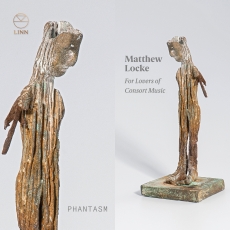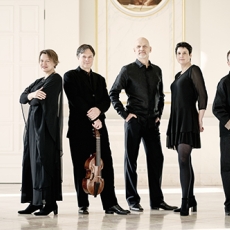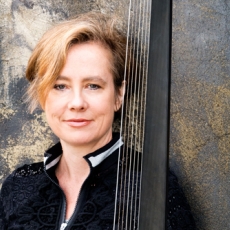Phantasm - Locke - Fanfare (JA)
It is always a pleasure to greet a new release by viol consort Phantasm—see my prior reviews of their discs of music by William Byrd (35:2), John Jenkins (40:3), and Christopher Tye (41:4)—and this offering of suites by Matthew Locke is no exception. At the time he wrote these works, Locke was conscious that the silver-toned, soft-grained viol consort was already passing out of fashion, giving way to the more powerful and assertive violin family as the preferred type of instruments for string ensembles. Of a famously contrarian and contentious temperament, Locke reacted defiantly by bringing the viol consort suite to a new height of sophistication, with special care taken in the selection and ordering of types of dance movements, the creation of slow introductions and final codas to provide greater structural unity, and the exploitation of the major-minor system and heightened use of dissonances for expressive depth and effects. Phantasm brings out all of these elements with its wonted skill and gleaming tone.
There are four previous versions of the six Consorts in Four Parts, played in their original scoring for viols: Phantasm’s own prior version on GMN (Global Music Network) from 2001 (which also included just the first of the Flat Consorts), reviewed by Brian Robins in 25:2; the 1996 recording by Fretwork on Virgin Veritas; the 1994 release by Audivis with Jordi Savall and Hesperion XX; and the 1991 issue by Alphée with the Ensemble de Violes Orlando Gibbons, a two-CD set which includes all eight suites on this new Phantasm disc plus Suites 1–3 from Part 1 of the Broken Consorts. In addition, there are two releases in arrangements for other instruments: a 2006 Aeolus disc by the Flanders Recorder Quartet, and a 2014 release on I Ching Music by French hornist Richard Burdick, in which he plays all the instrumental parts via repeated overdubbings. None of these six prior issues includes the two brief bonus canons in six parts that Phantasm features here. (On a side note, “broken consort” typically refers to a hybrid ensemble that mixes members of the viol and violin families, whereas “whole consort” designates a non-hybrid group.) Aside from this and the Alphée releases, I cannot locate any other recordings of the two Flat Consorts.
The GMN release is the only one of the foregoing with a previous review in Fanfare; Robins’s penetrating comments and comparison to the Fretwork version are very much worth reading. It is also the only version I have not been able to hear; I will rashly risk presuming that, since three of the four core personnel remain the same between Phantasm’s two recordings (Wendy Gillespie has been replaced here by Emilia Benjamin), the interpretations probably do not differ greatly. The Aeolus release is a marvelous delight in its own right, and I heartily commend it to fellow recorder fanciers; however, as much as I love French horn, the Burdick disc is a ludicrous, painfully misconceived venture. Of the four viol consort versions I have listened to—Savall, Fretwork, Gibbons, and this new one by Phantasm—all are quite worthwhile, and a choice between them will depend upon subjective preferences regarding such matters as tempos and the use and choice of optional additional continuo instruments. Savall employs a violone, harpe double, and chamber organ; Fretwork an archlute (played by Nigel North) along with either a chamber organ or spinet (played by Paul Nicholson); Phantasm opts for a theorbo, and the Orlando Gibbons foursome for no continuo parts.
Between the four, I’d rank Savall some distance behind the other three, as his performances seem somewhat heavy in texture and a bit sluggish, comparatively speaking. Phantasm is by contrast the most brisk and light-textured; I like them and Fretwork equally well, and would be hard-pressed to choose between the two. That said, the pioneering Alphée set might well be my desert island choice; the players have a sumptuous, luminous sound, and unlike with Savall their more expansive tempos succeed in being beautifully meditative and expressive without any sense of being ponderous. I’m not sure if the CD version is still in print, however, though a download is also listed on Amazon. In any event, Locke is well served here by several recordings, including this newest entry. All four of the in-print viol versions can be sampled on YouTube (albeit some industrious sleuthing is required), for those wishing to make comparisons before they buy.


